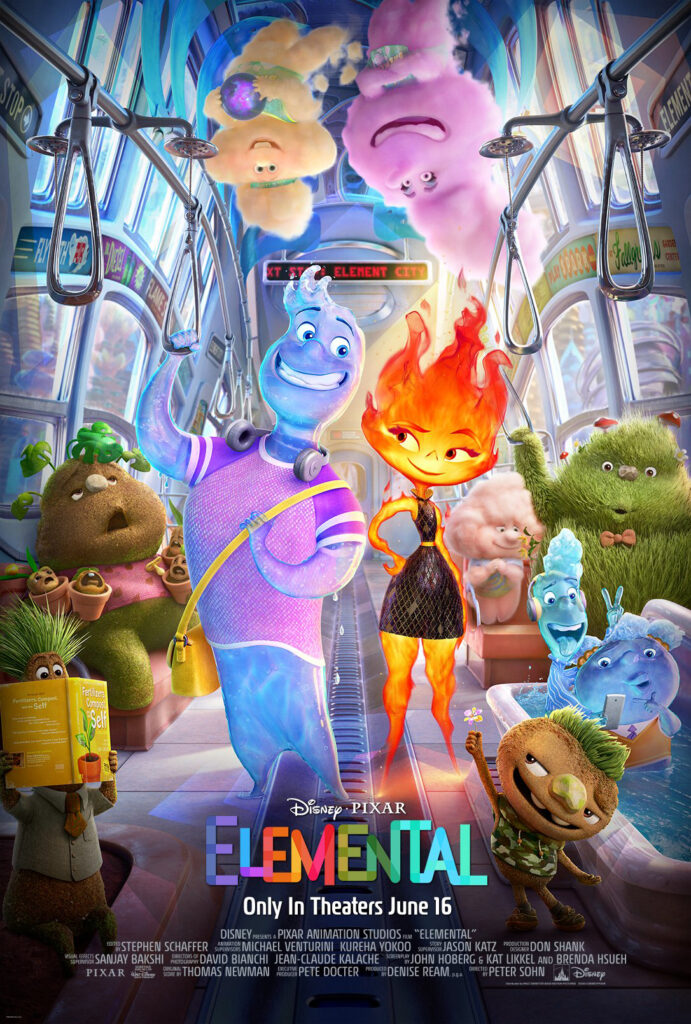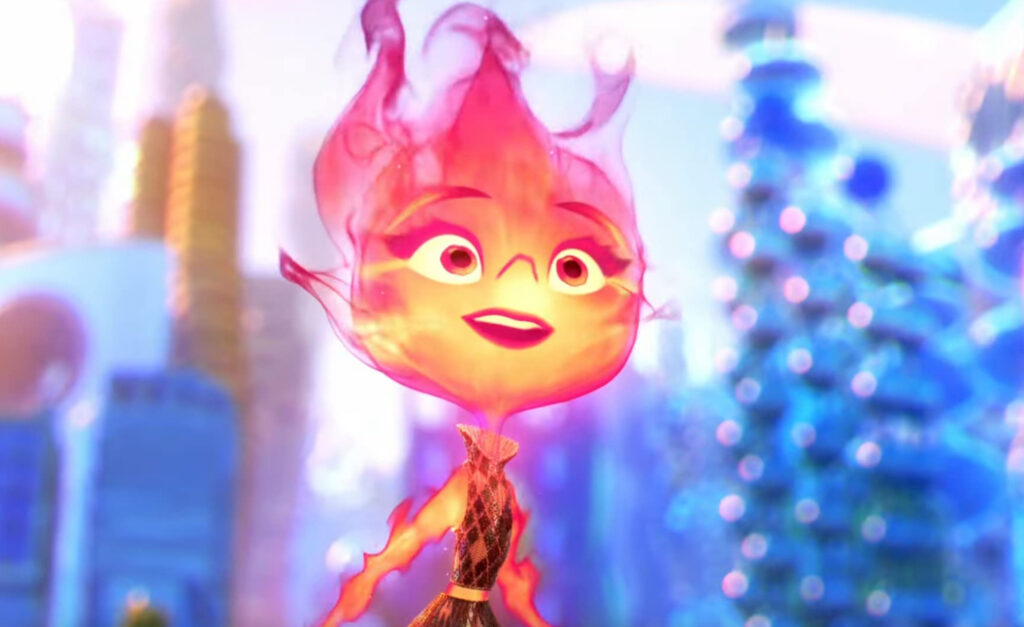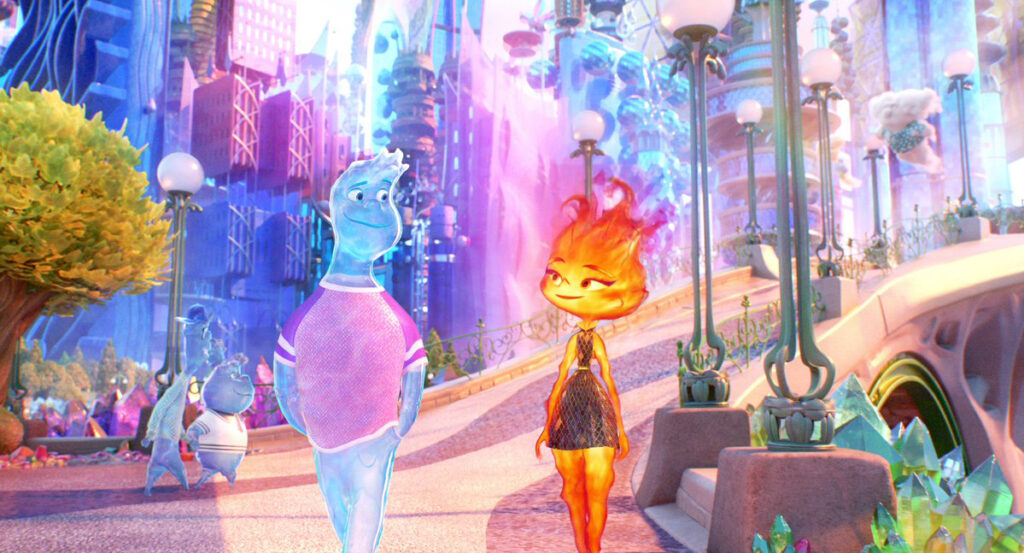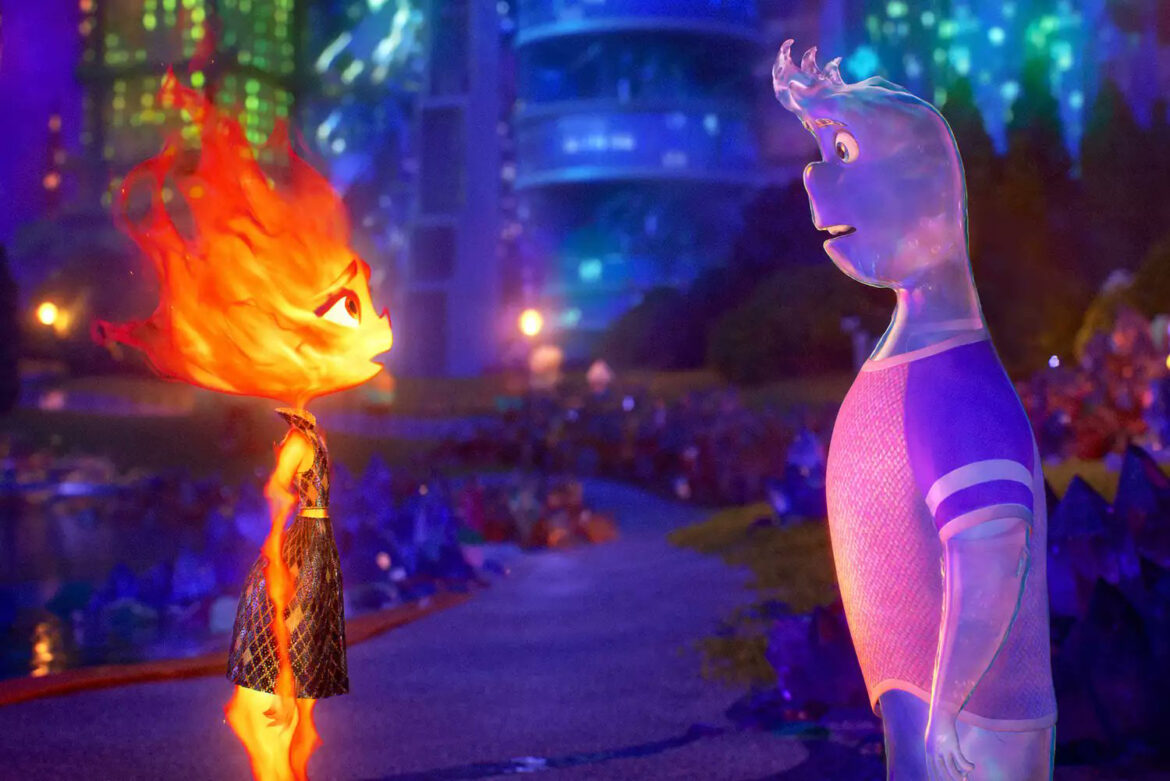By Kirsten Coachman
On Wednesday, May 10, Academy of Art University and the Art U Chapter of Women in Animation (WIAxArtU) hosted Pixar VFX Supervisor Sanjay Bakshi at the 79 New Montgomery theatre to discuss the animation studio’s newest release, “Elemental.”
Directed by Peter Sohn, the film, which hits theaters this weekend, centers on the fiery Ember, a young 20-something resident of Element City’s Firetown. She encounters Wade, a water resident who encourages her to reconsider the belief that “elements cannot mix.”
WIAxArtU officers Alina Jankowski and Emma Hollenberg kicked off the afternoon’s event with a brief introduction before passing the mic to Bakshi.
At the start of his career at Pixar in 2002, Bakshi brought his computer graphics and software engineering background to the studio’s tools department, where he built software for film projects.
For “Ratatouille,” Bakshi wrote the software for the film’s hair and fur system, which later was his entry point into working on the film’s production. “I thought it would be fun to try out being on the production, and instead of just making the software, making the characters,” he told Art U News following his presentation. “At Pixar, it’s pretty fluid; you can move between tools and working on the shows. I just fell in love with building characters, and just continue to do that.”

Bakshi has since worked on several Pixar films, including “Onward,” “Monster’s University,” and “Toy Story 3.” As a VFX supervisor, he described the job as being “that translator between the creative folks and the technical folks and understanding what the director is going for enough so I can guide and help.”
He worked on “Elemental” for three-and-a-half years, and when Bakshi first joined the film, there were storyboards available to work from. Then, it was about figuring out what kind of technical changes lay ahead. As an example, Bakshi highlighted in his presentation technical challenges from previous Pixar films, such as “Monsters, Inc.” and “Finding Nemo.”
One challenge in “Elemental” would be striking a balance between somewhat realistic-looking and “cartoony” characters, starting with Ember. The team was remote, as the film was created in the thick of the pandemic, and the creative teams worked in unison with the technical teams. They conducted sprints, working on as many versions of Ember as they could during the months-long process.
The VFX supervisor shared production shots and short clips for the students to get a better idea of the kind of work that went into the film, including some examples from the sprints where they worked on the character design for Ember.
The presentation closed with an extensive Q&A with the hybrid Academy audience. The students asked a wide range of questions, from rig development and the tech created to help with the effects to different references used in creating the film, as well as handling work/life balance while working on a long-term project.
“Because of the particularly impressive effects of ‘Elemental,’ it was great to hear [from Bakshi] as he could answer all of our complicated questions about the effects, and he could walk us through—from research to completion—and what was the hardest to execute,” shared Jankowski following the event, who also noted that WIAxArtU’s online community continued to chat about the film over Discord for the remainder of the day.
Additionally, the “Elemental” presentation served as a “full-circle moment” for the B.F.A. School of Animation & Visual Effects student; the first Academy event Jankowski attended as a student featured Pixar’s “Coco.” “It was a great atmosphere, full of great enthusiastic people, and it filled me with anticipation to think that all the people in that theatre were the people I’d start my career with,” she said. “Hosting the first such event since COVID is a great step toward getting back that kind of community feeling, and I was so glad to be a part of it.”
Following the “Elemental” presentation, Art U News sat down with Bakshi to further discuss the creation of the film’s main flame, Ember, setting the rules of the world of Element City, and what he hopes audiences take away from the film.
You talked about the research that went into the world-building for “Elemental” during your presentation—did you start with figuring out each individual character before sorting out how each environment would contain each element?
[It] kind of started with the characters. We knew if we could figure out what Ember would look like, it would really unlock what all of the other characters and the environments would look like. If we couldn’t get Ember right, then we were in trouble. So we really put a lot of effort into Ember early on to establish rules; like how cartoony are we going to make the fire, you know, how realistic should it be? And once we kind of figured out what Ember needed to be, then everything else fell into place because Ember and Wade had to look good together. One couldn’t be more realistic than the other; there’s a balance there. And we knew we had to get Ember right. So that was really the thing: to unlock what Ember would look like.
There were three-week-long sprints as you went through the different iterations of Ember. How long did those go on before you were like, “We’ve got her!”?
Yeah. I think it was like six to eight months of doing that.
Wow.
[Laughs]. Yeah. I remember starting in the fall-ish on those sprints and not being done ’til February-ish, like in the new year. So it was not a short amount of time.

Is that typical for any given Pixar character, or is it very specific for Ember?
I would say it took longer for Ember, and there were more people involved. We couldn’t do Ember without effects and animation. Whereas, like other films I’ve worked on—previously I worked on “Onward,” and [with] Ian, for instance, the main character, we didn’t need animators really early on because it was an elf, basically a human character. We kind of know what that stuff is. So it was a bigger team, and there was a longer runway for “Elemental.”
Interesting. When it came to creating the settings for each of the elements, how grounded in reality were you looking to make them? As far as the rules, did you have an idea of this is how we want them to work versus this is how we kind of need them to work?
Yeah, like the premise, there’s a big conceit in the movie that you have to believe that fire and water can’t touch each other. And so it had to be realistic enough for the audience to really viscerally believe that, so that meant that it had to be pretty realistic. That was kind of the guiding principle. The movie only works if the audience really believes that, you know, [they don’t] know what will happen when [the characters] touch. So that kind of guided that balance between realism and stylization.
At a VFX level, what are the challenges that come with that? Like, in knowing that there are very specific rules between how these characters have to interact?
Yeah, there are a bunch of moments in the film—like Ember has to leave Firetown and go to the city, and she’s on the subway train—this is in the teaser and the trailer—and there are all of the other elements there. She’s the only fire character, and when she gets close to them, if they’re water, they’ll start boiling up. If they’re kind of vegetation, they might get set on fire, so all of that stuff was in the [story]boards and really helped us. We had to establish the rules of the world and do all those visual effects so that the audience believed that when Ember leaves Firetown, she was out of her element.
You talked about how, typically, a Pixar movie has 35% of the shots go through VFX, and in this one, all of the shots had to be touched by the effects team. And you also mentioned building tech for some of them to go through and then the rest going to the effects team. How do you make that decision between which shots will be the hands-on shots versus other shots?
We started by building a pipeline, [and] we were hoping that some of the simpler shots wouldn’t have to go to the effects department. And we were hoping, like maybe 30, 35% wouldn’t have to go to the effects department. And so we do this spotting pass: We actually go through the shots in the sequence, and we would mark them before they’re animated, like, that’s a pretty simple shot—it’s just Ember walking into the room and talking to her dad. So that one, we would say, hopefully, won’t go through to the effects department, and we would set a status in the database for that shot. We actually kept track of it. Then, when it came out of animation, we would look at it and see if our assumptions were correct.
The interesting thing about it is, early on, all of the shots had to go through the effects department because we didn’t have that kind of tuned well. The effects department would take that kind of simpler shot and be like, “Oh, the reason why it doesn’t work is this, so let’s build that into the rig. So next time, if we get a shot like that, it will be automatic.”
Originally, at the beginning of production, a lot of shots went through the effects department. We honed those rigs, and then a bunch of shots didn’t [have to], and we were really benefiting from the kind of automatic procedure. At the end, all the hard shots were left, and they all went through the effects department. So it was kind of this interesting waveform of a bunch of shots going through effects, [then] none, and then a bunch at the end, ’cause all the hard shots were at the end of the film.

After finalizing Ember’s character design, how long did it take to create Wade and the other elements?
Wade took about the same amount of time, but it was in parallel. So we started Ember, and a few weeks in, we started Wade, and then those took six to eight months to hone in. All of the fire and water characters after that were pretty relatively easy because we had the tech for fire [with] Ember, and [water with] Wade. The air characters themselves, we used a lot of the same tech as the water characters and the earth characters. We didn’t have to do a lot of pre-pro; we kind of knew how to build those ones. In order of complexity, Ember and Wade were the hardest. Air would be behind them. And then earth characters were the least complex. We try to find a sequence with only a few characters so we can build the rest while animation has already started.
Working at Pixar is often an end goal for animation students coming out of school. Now that you’ve worked at Pixar for some time, what is something that you wish you’d known beforehand?
I feel like your students are really well-positioned because you’re teaching them technical skills but also artistic skills. And that’s something that I don’t have any formal training in. I wish I would’ve taken film classes or art classes ’cause I had to learn all of that on the job at Pixar. When I went to school, I did computer science, and there wasn’t really an opportunity to learn about animation, and film, and art. And so, for me, that’s what I wish I would’ve known more about and spent more time on. But I think your students are generally doing a lot. It’s a pretty diverse curriculum.
What do you enjoy about being able to talk to animation students about a project that you’ve worked on?
It’s fun to talk about ’cause it’s finished, you know, so that every time I talk about it, I realize, “Oh yeah, we did finish it.” So that feels good. The questions today, like you could tell people are really interested in animation; they’re very knowledgeable about, you know, pipelines and animation. So coming here to talk to students is kind of special ’cause the questions are generally good questions, you know? And it also kind of reassures me that we focused on the right things. If they talk about like, “Well, how did you get the elements to feel like the elements?” And we spent a lot of time on that. So if you’re talking to animation students and they’re kind of curious about the things you spent a lot of time on, that’s reaffirming.
What are you hoping the general audience takes away from the film?
I think there’s something in it for people who grew up as immigrants. I think they’ll be able to see moments of it that feel authentic, and they’ll see themselves in the film. So I think that’s really valuable, and I’m proud of that. And then, on the other side, I think people who aren’t immigrants will see a window into what that feels like, and maybe there’ll be some empathy that can come from it. Those are my two hopes for it. I hope it’s successful and all of that. It’s a joy to me that there’ll be immigrant kids being able to watch this film and see themselves reflected in it and some of their emotions authentically conveyed in the film.
“Elemental” is now playing in theaters. This Q&A has been edited for length and clarity.
